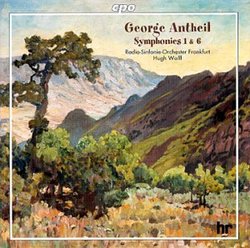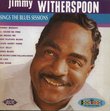| All Artists: George Antheil, Hugh Wolff, Frankfurt Radio Symphony Orchestra Title: George Antheil: Symphonies 1 & 6 Members Wishing: 0 Total Copies: 0 Label: Cpo Records Release Date: 5/16/2000 Genre: Classical Styles: Ballets & Dances, Dances, Historical Periods, Modern, 20th, & 21st Century, Symphonies Number of Discs: 1 SwapaCD Credits: 1 UPC: 761203960422 |
Search - George Antheil, Hugh Wolff, Frankfurt Radio Symphony Orchestra :: George Antheil: Symphonies 1 & 6
 | George Antheil, Hugh Wolff, Frankfurt Radio Symphony Orchestra George Antheil: Symphonies 1 & 6 Genre: Classical
|
Larger Image |
CD DetailsSimilar CDs
|
CD ReviewsBad Boy just had Bad Rep philvscott | Marrickville, New South Wales Australia | 08/23/2000 (5 out of 5 stars) "The self-styled "bad boy of music", George Antheil, turns out to have had the famous attribute of the bad girl- namely, when he was good, he was very VERY good. At least, that's my feeling after listening to the first in the Hugh Wolff/cpo series of his complete symphonies. It's an eye (or ear-) opener, especially after the Ensemble Modern (RCA) recording of the Ballet Mechanique and other bits and pieces. The Symphonies 1 & 6 show Antheil to have been a deft hand with an orchestra and, while not giving himself over completely to "quirkiness", retains enough of that boisterous quality to bring the well-worn symphonic form to life, especially in the 1st. I look forward to the rest of the series. Wolff and his Frankfurt Orchestra play superbly and reveal the detail of Antheil's inspiration with greater clarity (in No.6) than Kuchar on a new Naxos release, although the Naxos is still a good buy. Who said everything worth hearing had already been recorded? This issue (like so much else in the cpo catalogue) proves them wrong." Early and late Antheil - a significant addition to the ongoi Discophage | France | 04/18/2007 (4 out of 5 stars) "In his (in)famous autobiography "Bad Boy of Music", written in 1945, George Antheil has a lot to say about his first Symphony. No wonder: a "first" will always have a special significance to its author, and it was also the first big symphonic piece of Antheil to get a performance - and by a major symphony orchestra to boot. Completed in the early months of 1922, prior to Antheil's departure to Europe (rather than in 1923 as indicated on the back cover), under the tutelage of his composition teacher Ernest Bloch, it was programmed by no less than Stokowski for his new Philadelphia season, but ultimately was premiered by the Berlin Philharmonic (not bad either!) under the German conductor Rudolph Schulz-Dornburg (and not "Schultz von Dornberg", as Antheil approximately reminisces in 1945). Antheil writes endearing pages (Chap. 6) about how it feels for a young composer to hear HIS own orchestral composition rehearsed and performed for the first time: "even though I live to be a thousand years old I ill never forget the first morning's rehearsal of my First symphony!" I was, then, curious to hear it and see if I would recognize the passage he had orchestrated "one day after canoeing on the Delaware River", the part where the odor of blooming honeysuckled got entwined into the orchestration, the parts which he now felt, on hearing the music, sounded too much like Bloch. Indeed, Bloch and "Schelomo" are very much the driving influence in the first movement, integral with the somber, brooding cello melody (0:12 and again 0:49). The idiom is a late-Romanticism verging on impressionism, with sensuous and sinuous melodies and lush orchestration; composers like Loeffler, D'Indy, Ibert ("Ports of Call"), Suk ("Azraël") also come to mind. The moods alternate between the starkly menacing and the flute-driven pastoral (3:06 - a good candidate for the honeysuckle odor, and for the Delaware River I would elect the passage starting at 2:32). One of Antheil's favorite compositional devices (and not only in the first movement) is to establish a certain mood, merry or pastoral, only to suddenly interrupt it with brutal onslaughts of sinister chords played on low brass (try 0:33, 3:33 and again 6:05 in the 1st movement, 1:25 in the 2nd, 1:51 and 5:17 in the 3rd) - a harbinger of the Antheil soon to come, adept of the "Collage technique" and construction by block juxtaposition. It is in the 2nd movement "Scherzo" and the Finale "Ragtime" that Antheil's Collage technique and jarring interruptions of one section by another are most in evidence. Of the "Scherzo", Antheil wrote that he composed it "on a number of July nights, with the memory of skyrockets in the sky above and patriot airs sounding dimly over the river waters". One does hear that (along with some whiffs of Debussy's Iberia or Ravel's Rhapsodie Espagnole, and more Bloch - try the viola melody at 2:03), but Antheil's 4th of July sounds very much like Stravinsky's Petrushka's fair, especially at 3:23 (Antheil played by heart the 3 movements for piano in those years), at one point leading directly into "Le Sacre" (5:47). The finale recapitulates and brings to extremes of pounding themes from the earlier movements, but also develops on a new theme of somewhat "Chinese" contour, which also forms the basic motive of the First Piano Concerto (see my review of Piano Concertos of the Twenties) - not surprising, as both pieces were composed at the same time. The movement has an abrupt and explosive ending, as "Le Sacre" (and the Piano Concerto). Again both the Stravinsky influence and this block construction technique announce the Antheil soon-to-come, who would so often make direct quotations of the Russian composer (his compositional God in those years), but also strike his own personal and inimitable mark by bringing Stravinsky's compositional traits to outlandish extremes of barbaric pounding and block-construction-without-development (see my reviews of the Piano Concerto and of George Antheil: Violin Sonatas 1, 2 & 4). Indeed, Antheil's mischievously biting and sometimes hammering tunes in these two movements point to the savage piano music he will start composing immediately thereafter - and I'll bet that the passage at 4:20 is where the Berlin Philharmonic clarinetist, finding his slightly "jazzy" part "unspeakably funny", burst into laughter, to the young composer's initial dismay. The same kind of pointer to the "mechanistic" Antheil can also be found in 3rd movement's celesta 4-note ostinato that underpins the wistful and sensuous melody of Blochian contour first played by cor anglais (or is it a sweet-sounding oboe?); these wistful melodies ("old sad tunes with heart-breaking memories" Antheil said of them) over various ostinatos circulate throughout the movement, interrupted by sinister and brassy onslaughts. With all its references and influences the First is not an entirely mature work (how could it?) but it is so full of surprises as to make for a highly rewarding listening. The Sixth "after Delacroix" and his famous painting "Liberty Leading the People" is Antheil's own "1905" Symphony (Shostakovich's 11th, a tribute to the first attempt at a revolution in Russia). Its three movements depict the Revolutionary Battle, the Mourning, the Victory. The simple and sparse textures of the middle movement (flute and oboe, soon with celesta punctuations, hovering over slow waltz chords on the strings) recall similar movements by Shostakovich. The outer movements are dramatic, urgent, mischievous, even angry - but also pretty bombastic. Even more than Shostakovich, it is here Myaskovsky that comes to mind. There his a passage in his bio in which Antheil pretends to be astounded that composers set so much store on finding a personal "style", rather than expressing "the form". So perhaps the Sixth is a fine realization of Antheil's idea of form, but it is rather impersonal and could not in itself lay any claim on a place in posterity, if it wasn't as an example of the "later" style of the composer whose "style" and peculiar and outlandish sense of form in the 1920s were so inimitably unique. " Two Must Hear Symphonies D. A Wend | Buffalo Grove, IL USA | 11/21/2000 (5 out of 5 stars) "George Anthiel could be called the fourth American composer. During his life, he was the fourth most hear composer, after Gershwin, Copland and Barber. The First and Sixth are exgaging works of this talented man. The First is original on concept and orchestration. Anthiel keeps you on the edge of your seat with the unpredicatable turns his music takes. One has no trouble believing it was great fun to write this work. The Sixth reminded me of Shostakovich and Prokofiev. It is a symphony inspired by Delacroix rather than meant to depict his paintings. Anthiel set out to become the bad boy of music, and he succeeded. However, it is the musician and not the bad bod that comes out in these two symphonies. Since this is Anthiel's centenary (July 8) we should become acquainted with his music for it is rich and rewarding, and as entertaining as his life is to read."
|

 Track Listings (8) - Disc #1
Track Listings (8) - Disc #1

